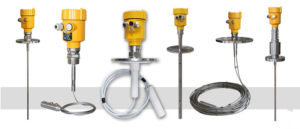Radar level meters emit microwaves, which are electromagnetic waves. The reflectivity of the electromagnetic wave signal is influenced by the size of the dielectric constant of the liquid being measured. When the radar waves emitted by the radar level meter reach the surface of the liquid medium, refraction and reflection will occur.
The greater the dielectric constant of the liquid medium, the smaller the loss of reflected energy, the stronger the reflected signal received, and the more accurate the measurement. Conversely, the lower the dielectric constant of the liquid medium, the more serious the signal attenuation, the weaker the reflected signal received, and the greater the impact on the measurement. From this point of view, the dielectric constant has an influence on the radar level measurement. However, this problem has been well solved.
| NO. | Name | Dielectric constant | Et(25℃, Polarity) |
| 1 | water | 78.5 | 63.1 |
| 2 | formic acid | 57.9 | |
| 3 | formamide | 109.5 | 56.6 |
| 4 | ethylene glycol | 37.7 | 56.6 |
| 5 | methanol | 32.6 | 55.5 |
| 6 | n-methy1 formamide | 182.4 | 54.1 |
| 7 | C2H50H/H2O (80/20) | 53.6 | |
| 8 | Methyl cellosolve | 15.95 | 52.3 |
| 9 | ethanol | 24.3 | 51.9 |
| 10 | acetic acid | 6.19 | 51.9 |
| 11 | benzyl alcohol | 13.6 | 50,8 |
| 12 | 1-propanol | 19.7 | 50.7 |
| 13 | 1-butanol | 17.7 | 50.2 |
| 14 | 2-propanol | 18.3 | 48.6 |
| 15 | 4-methyl butanol–1 | 15.2 | 47 |
| 16 | propylene carbonate | 65.1 | 46.6 |
| 17 | nitromethane | 38.6 | 46.3 |
| 18 | acetonitrile | 37.5 | 46 |
| 19 | dimethyl sulfoxide | 48.9 | 45 |
| 20 | aniline | 6.98 | 44.3 |
| 21 | sulfolane | 44 | 44 |
| 22 | t-butanol | 12.2 | 43.9 |
| 23 | dimethyl formamide | 36.71 | 43.8 |
| 24 | acetone | 20.5 | 42.2 |
| 25 | nitrobenzene | 34.6 | 42 |
| 26 | cyanobenzene | 25.2 | 42 |
| 27 | dichloroethane | 10.37 | 41.9 |
| 28 | acetophenone | 17.4 | 41.3 |
| 29 | dichloromethane | 8.9 | 41.1 |
| 30 | tetramethyl urea | 23.1 | 41 |
| 31 | pyridine | 12.3 | 40.2 |
| 32 | quinoline | 9.22 | 39.4 |
| 33 | chloroform | 4.7 | 39.1 |
| 34 | a-picoline | 9.94 | 38.3 |
| 35 | 1, 2-dimethoxyethane | 3.5-6.8 | 38.2 |
| 36 | ethy1 acetate | 6.03 | 38.1 |
| 37 | fluorobenze | 5.42 | |
| 38 | bromombenzene | 5.39 | 37.5 |
| 39 | o-dichlorobenzene | 3.03 | |
| 40 | chlorobenzene | 5.61 | 37.5 |
| 41 | tetrahydrofuran | 7.39 | 37.4 |
| 42 | anisole | 4.3 | 37.2 |
| 43 | 2, 6-1utidine | 7.23 | 36.7 |
| 44 | 1, 4-dioxane | 2.21 | 36 |
| 45 | diphenyl ether | 3.68 | 35.3 |
| 46 | diethyl ether | 4.22 | 34.6 |
| 47 | benzene | 2.27 | 34.5 |
| 48 | toluene | 2.38 | 33.9 |
| 49 | carbon disulfide | 2.64 | 32.6 |
| 50 | carbon tetrachloride | 2.23 | 32.5 |
| 51 | triethylamine | 2.44 | |
| 52 | n-hexane | 1.9 | 30.9 |
| 53 | i-octane | 1.94 |
Firstly, guided wave radar level meters are then very good at measuring the level of low dielectric constant liquids. The radar waves emitted by a guided wave radar level meter are propagated through the detection assembly, which, to a certain extent, converges the radar wave energy, reduces the degree of attenuation, and ensures measurement accuracy.
Therefore, for low dielectric constant liquid level measurement, a guided wave radar level meter can be used. For example, a guided wave radar level meter can measure media with a dielectric constant greater than or equal to 1.6.
Secondly, the radar level meter antenna installation casing can cope with the liquid level measurement with a low dielectric constant. When the radar wave reaches the interface of a liquid with a low dielectric constant, the reflected signal will be attenuated, affecting the accuracy of the measurement, while the casing has a focusing effect on the radar wave emitted by the radar level meter, which, to some extent, can enhance the reflected wave and improve the measurement accuracy. Some data show that liquid levels with a dielectric constant of 1.6 to 3 can be measured perfectly by a radar level meter fitted with a casing.
Looking at the problem of subjectivity, one-sidedness and superficiality is a philosophical principle that we have already learned in high school. So for radar level meters, we cannot generalize that low dielectric constant liquid level measurement is not suitable for radar level meters. Instead, we should learn to analyze the specific problem, depending on how low the dielectric constant is.

